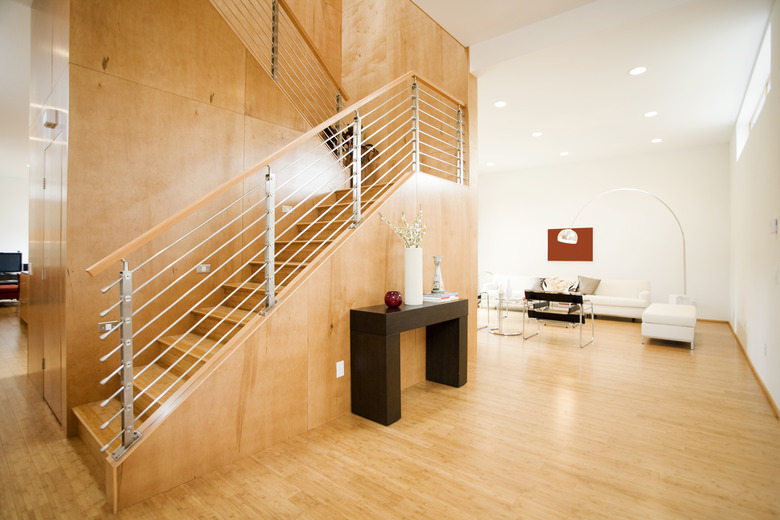How To Put Bullnose On Wooden Stairs
We may receive a commission on purchases made from links.
The horizontal, flat part of a stairway is the tread, and it typically overhangs the vertical part of the step — the riser — by about 3/4 inch. The overhang has to be rounded to prevent people from catching their feet on it and tripping. This rounded overhang is what is known as bullnose.
If you're installing solid wood treads, they may come from the shop with a preshaped bullnose, and if not, you can use a router to preshape the bullnose yourself before you install the treads. Some situations, however, call for bullnose molding to be added after you cover the treads. The two most common situations are when you cover the treads with laminate or hardwood flooring and when you install laminate or hardwood flooring on the landing at the top of the stairs. The best technique depends on what you're working with.
Here's what to know about installing bullnose on wooden stairs.
Adding Bullnose to Laminate Steps
Adding Bullnose to Laminate Steps
When you cover stair treads with laminate flooring, you need specialty bullnose molding that matches the flooring. It has a 1- or 2-inch section of flooring material attached to a section of rounded bullnose, which overhangs the riser on the lower step. The edge of the molding may be cut square, but it usually has a small lip that overlaps the flooring. In the first case, it's easier to install the bullnose before the flooring, and in the second case, it's easier to install the flooring first.
You should always glue laminate to the stair tread to prevent slipping, and the same is true for bullnose. Apply a bead of construction adhesive to the underside of the bullnose, fit it into place on the step (after you've installed the riser on the lower step), and secure it with 6D finish nails. If you don't use a nail gun, drill pilot holes for the nails with a 5/64-inch drill bit to prevent cracking and splitting.
Installing Ungrooved Bullnose on Hardwood Steps
Installing Ungrooved Bullnose on Hardwood Steps
Like laminate bullnose, the bullnose molding for steps covered with hardwood flooring is formed like corner trim, and it's designed to fit around the outside corner of the tread. The lower, rounded section covers the top of the riser on the lower step, and the upper part that sits on the tread is the same thickness as the hardwood.
You can install the bullnose before or after you install the flooring on the step. If you install it before you install the flooring, you can butt the hardwood planks against it. If you install it afterward, you have to premark a line on the steps that corresponds to the edge of the bullnose molding so you'll know where to end the flooring. This method is less accurate than the first. Either way, the bullnose should be glued to the step as well as nailed for security.
Installing Grooved Bullnose
Installing Grooved Bullnose
Some bullnose designed for hardwood flooring is pregrooved, and you can always cut a groove using a router or table saw. The groove makes it possible to connect the bullnose to the flooring. If the tongue sides of the boards are facing the edge of the step, the bullnose can fit over the tongues. If the groove sides are facing the edge of the step, you need a spline.
A spline is a length of wood with the same thickness as the groove and a width a little less than twice the depth of the groove. You can cut this yourself from scrap flooring using a table saw. It doesn't have to extend the whole length of the molding; several shorter pieces work just as well. Coat the spline with wood glue, tap it into the flooring, and then coat the inside of the groove on the molding with glue and tap it onto the spline. When the joint is tight, nail the molding to the stair tread.
